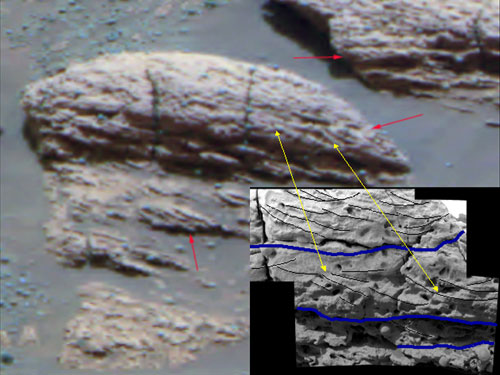 Following
on the heels of an announcement two weeks ago that researchers had found direct
evidence for groundwater on Mars (see Geotimes
coverage), the Mars Exploration Rover (MER) team said yesterday that they
have found evidence for standing water on the planet's surface.
Following
on the heels of an announcement two weeks ago that researchers had found direct
evidence for groundwater on Mars (see Geotimes
coverage), the Mars Exploration Rover (MER) team said yesterday that they
have found evidence for standing water on the planet's surface.Cross-lamination patterns in a rock called "Last Chance" required flowing water at Mars' surface, according to the Mars Exploration Rover team. Inset: Black lines trace cross-laminations, in magnified images taken by Opportunity (at yellow arrows). Blue lines show boundaries where deposition may have halted between crossbedded sets. Red arrows indicate other possible crossbedding in the rock. Image courtesy of NASA/JPL/Cornell/USGS.
At a press conference at NASA headquarters, John Grotzinger of MIT, and a geologist for the MER team, described ripples and cross-stratification in the approximately 30- to 50-centimeter-thick outcrop that the rover Opportunity has been examining for the past few weeks. The crossbedding was formed in water, which probably moved between 10 and 50 centimeters per second, Grotzinger says, in the equivalent of a nearshore environment. "If you were out there, you would feel the water moving around your ankles, and it would be about that deep," he says.
The team thinks that a shallow sea may have been present in the region, which was alternately wet and dry. Adding the surface-water crossbedding to other evidence, such as wind-blown deposits, crinkly lamination and soft-sediment folds found elsewhere in Opportunity's landing crater, Grotzinger says that the best equivalent on Earth for the Mars environment is a playa lake, which is often moist, as well as dry and wet below the surface.
When wet, the water present would have produced ripples that made centimeter-scale concave-up crossbeds, and when dry, it created evaporite deposits (see previous coverage by Geotimes). The episodic periods may have been from daily floods, seasonal climatic changes, "or longer-term intervals of wet climate or dry," Grotzinger says.
The origin of the water remains unclear; it may be from surface precipitation or the melting of ice layers elsewhere. For example, as Grotzinger describes in one possible scenario, water from ice melting underground may have come up to the surface and pooled, or perhaps flowed from another basin into the region Opportunity is now exploring. He says that the rock unit containing the ripples is "likely part of a larger regional unit that extends for hundreds of kilometers — either overlain by younger rock or eroded away and we can no longer see evidence for it."
The three or four layers of ripples the team examined also have breaks in deposition between them. "We just don't know how much time is represented between the layers," Grotzinger says.
Dave Rubin, a sedimentologist at the U.S. Geological Survey Pacific Science Center in Santa Cruz, Calif., who is not a MER team member, noted at the press conference that the crossbedding "looks more like ripples than anything deposited by air." On Earth, such "smile-shaped" crossbeds of a similar size and thickness could have formed in a little creek in less than an hour, he said. "It doesn't have to take a long time, but it requires flowing water," Rubin said. He also said he could find examples of playas that would fit the requirements for a transitional environment in Northern China. Another plausible way to create such crossbeds, Rubin said, would be from very small windblown bedforms, but even those require water just beneath the surface.
"Again, we've done all of this on the basis of one spot," said Steven Squyres, principal investigator of the project, also at the press conference. "It's hard to draw inferences of how long things took from the chemistry — any geologist will tell you that you need a stack of rocks" to come to any conclusions.
While describing future plans for exploring Mars, James Garvin, NASA's Lead Scientist for Mars and the Moon, said that the Opportunity and Spirit might have their missions extended until late summer, and maybe even until September.
Naomi Lubick

